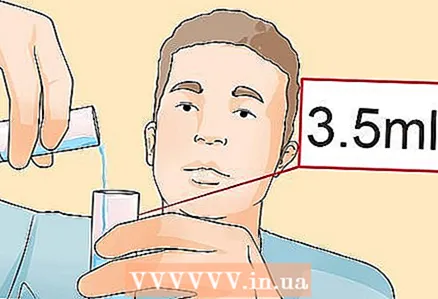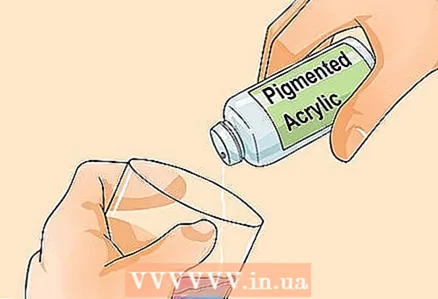
Content
- Steps
- Method 1 of 2: Making acrylic paint
- Method 2 of 2: "Fake" PVA glue acrylic paint
- Warnings
- What do you need
- Acrylic paint preparation
- "Fake" acrylic paint from PVA glue
Artists love to use acrylic paint because of its property of simulating the transparency of watercolor paint and the opacity of oil paint at the same time. In addition, acrylic paints are much safer than oil paints and are more heat resistant. Andy Warhol, Roy Lichtenstein, Mark Rothko and David Hockney are some of the most famous artists of the twentieth century who often used acrylic paints in their works. Try making your own acrylic paint, which will allow you to control its composition and save some money. If you buy four liters of acrylic base and a few pigment concentrates or pigment powders from an art supply store, you will get more paint and at a lower cost than buying paint in tubes or cans. If you don't have a store nearby or don't have the materials you need, try the “fake” acrylic paint method.
Steps
Method 1 of 2: Making acrylic paint
 1 Stock up on everything you need. You will need:
1 Stock up on everything you need. You will need: - plastic mixing container;
- wooden stick;
- dry pigment;
- painting spatula;
- base for acrylic paint;
- solvent (water or rubbing alcohol);
- retarder for drying acrylic paints.
 2 Grind dry pigment. Crush the pigment with the flat side of the trowel until it stops squeaking like sand. The pigment, which can be found at an art supply store, is usually sold in powder form.Many artists also use pigments from crushed dried plants and other substances.
2 Grind dry pigment. Crush the pigment with the flat side of the trowel until it stops squeaking like sand. The pigment, which can be found at an art supply store, is usually sold in powder form.Many artists also use pigments from crushed dried plants and other substances. - Grind the pigment until it stops squeaking like sand. Most pigments disintegrate quite easily, so make sure there are no lumps left in the pigment.
- If you bought the pigment in powder form and there are no lumps in it, then you do not need to grind it.
 3 Measure and record the amount of pigment and acrylic base. Measure and record the amount of pigment and base used before mixing the components. You may need to prepare a few paints to complete the painting or retouch it. To get it right, you need to know how much pigment and foundation you used.
3 Measure and record the amount of pigment and acrylic base. Measure and record the amount of pigment and base used before mixing the components. You may need to prepare a few paints to complete the painting or retouch it. To get it right, you need to know how much pigment and foundation you used. - Basically, the base for acrylic paint is the paint itself, without the pigment. As a rule, it is supplied in tubes and is white. There are several types of base (for example, gloss or matte paint) and you need to decide which type of paint will work for your painting.
 4 Mix the base pigment in a plastic container. Stir everything with a wooden stick until the pigment is evenly distributed over the base.
4 Mix the base pigment in a plastic container. Stir everything with a wooden stick until the pigment is evenly distributed over the base.  5 Stir the colored base well with the solvent. Read the instructions on the packaging with the acrylic binder, as each brand has a different base to solvent ratio.
5 Stir the colored base well with the solvent. Read the instructions on the packaging with the acrylic binder, as each brand has a different base to solvent ratio. - Some pigments (especially organic ones) float in water. In this case, the water must be replaced with alcohol. Use a solvent according to the selected pigment.
- Alcohol is not very suitable for acrylic paint, as it will dry out the paint quickly. If you bought a pigment that needs to be thinned with rubbing alcohol, but want the paint to dry more slowly, mix the pigment with rubbing alcohol and then just add water.
- Too much water or alcohol can dilute the acrylic binder, so be careful.
 6 Add a retarder for acrylic paints. A retarder slows down the drying of acrylic paints. Use it strictly according to the instructions on the package. But generally, the more retarder, the slower the paint dries. With time and practice, you should be able to choose the right amount of retarder without any problem.
6 Add a retarder for acrylic paints. A retarder slows down the drying of acrylic paints. Use it strictly according to the instructions on the package. But generally, the more retarder, the slower the paint dries. With time and practice, you should be able to choose the right amount of retarder without any problem. - A retarder for acrylic paints is especially important if you want to paint a photorealistic painting or portrait of a person. To draw the outlines of complex shapes, colors need to be mixed on the canvas, but acrylic paint can dry out faster than you can add a second color.
Method 2 of 2: "Fake" PVA glue acrylic paint
 1 Prepare everything you need in one place. Although not real acrylic paint, it is more convenient to use and is therefore great for more inexperienced artists. You will need the following:
1 Prepare everything you need in one place. Although not real acrylic paint, it is more convenient to use and is therefore great for more inexperienced artists. You will need the following: - plastic mixing container;
- wooden stick;
- liquid paint;
- ordinary PVA glue.
 2 Pour an equal amount of liquid paint and PVA glue into the mixing container. The ratio can be changed slightly to correct the clarity of the color, but too much water-based paint can ruin the adhesive.
2 Pour an equal amount of liquid paint and PVA glue into the mixing container. The ratio can be changed slightly to correct the clarity of the color, but too much water-based paint can ruin the adhesive. - Some types of PVA glue, when dried, become more transparent than others. If you want more vibrant colors (rather than pastels), buy glue that becomes more translucent as it dries.
 3 Stir the paint and glue well with a wooden stick. The "fake" acrylic paint will be ready in a couple of minutes.
3 Stir the paint and glue well with a wooden stick. The "fake" acrylic paint will be ready in a couple of minutes.  4 Be careful. Unlike water-based paint, this new paint will adhere to almost any surface.
4 Be careful. Unlike water-based paint, this new paint will adhere to almost any surface.
Warnings
- Be careful not to get paint in your eyes. If this does occur, flush your eyes with water and seek immediate medical attention.
What do you need
Acrylic paint preparation
- Plastic mixing bowl
- Wooden stick
- Dry pigment
- Painter's spatula
- Acrylic paint base
- Solvent (water or alcohol - vodka will do)
- Acrylic paint drying retarder
"Fake" acrylic paint from PVA glue
- Plastic mixing bowl
- Wooden stick
- Liquid paint
- PVA glue



